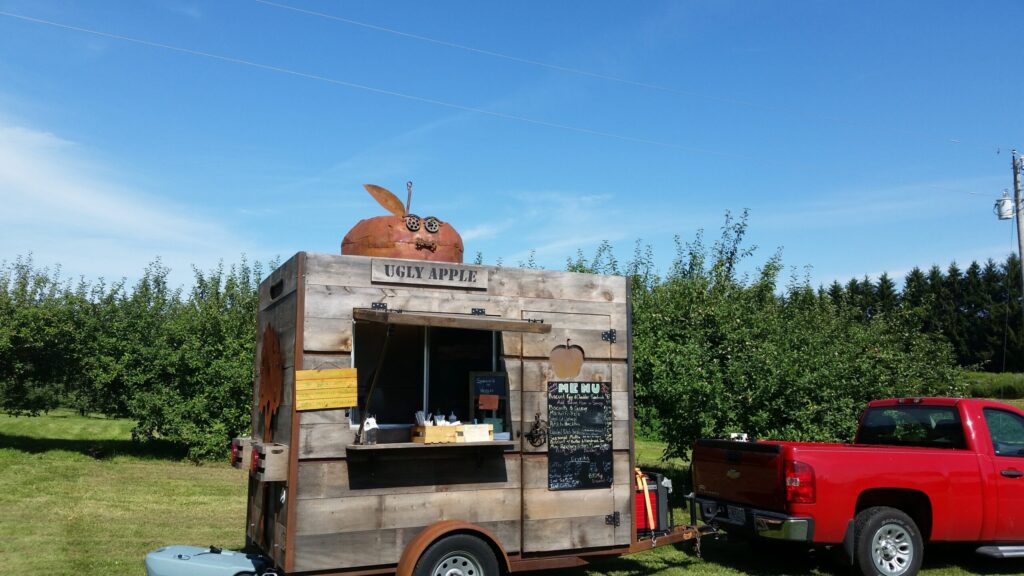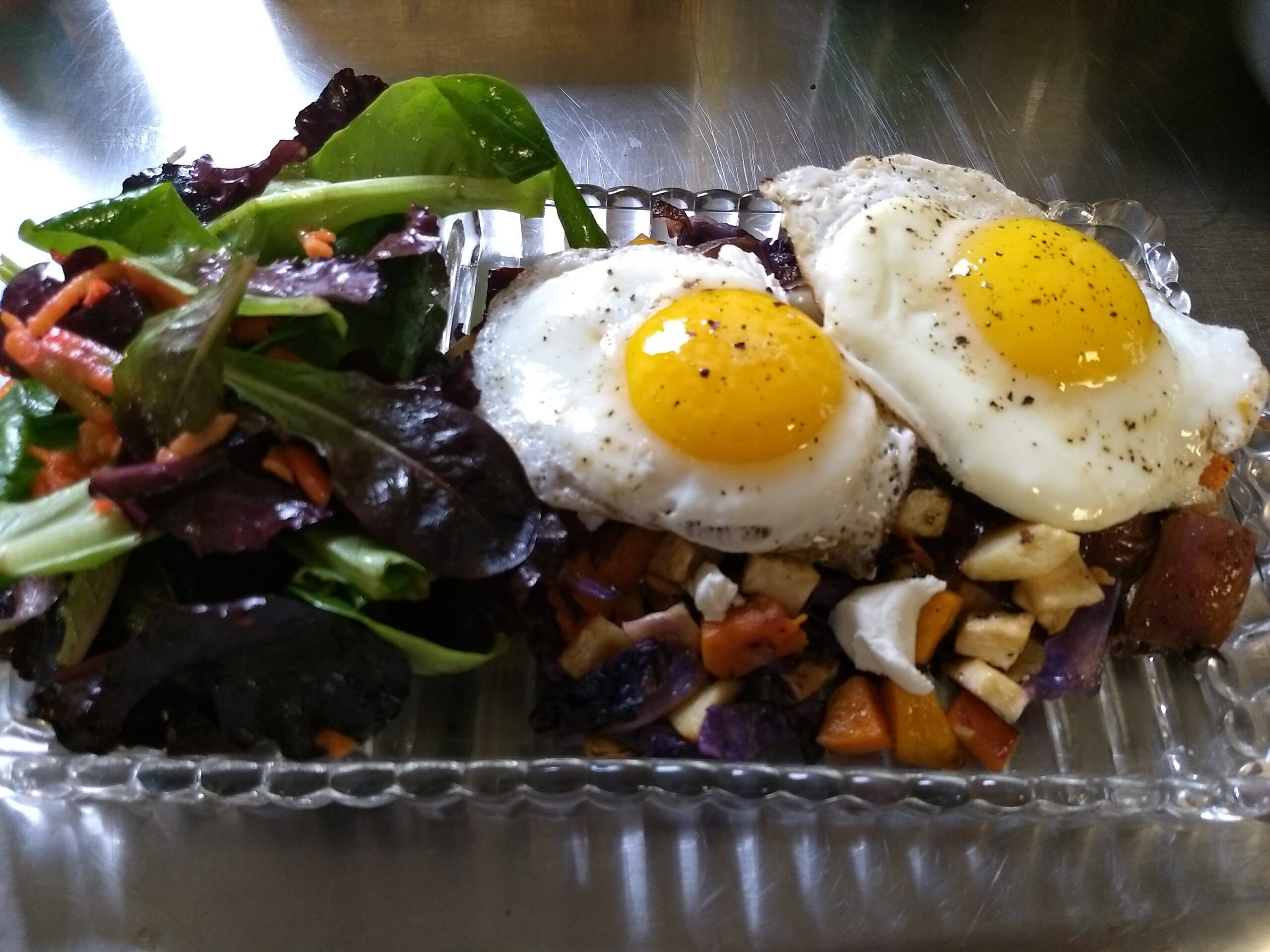
Finding the Beauty in Ugly Apples
By Moji Igun
I had a conversation with Laurel Burleson, owner and chef at Ugly Apple Cafe. We talked about her most interesting recipe, what makes her food cart unique, and how she’s working to save as many “ugly” fruits and veggies as possible.
Tell me a little bit about yourself and what led you to start the Ugly Apple Café.
Laurel: I started cooking when I was pretty young. I have an older sister. It’s just the two of us. My mom went back to working full-time from part-time so she had longer hours when I was in junior high. She would leave me something to start for dinner because she wouldn’t get home until 5:30 or 6 and we had evening activities that we had to get to. We couldn’t postpone dinner until she had time to do it, so she would leave it to me. Typically, it was something along the lines of Hamburger Helper or a casserole or something frozen and then I got creative with it.
That sparked an interest and I got my first kitchen job in high school and really liked it. Then I went to school for hospitality management. I thought I wanted to run a high-end restaurant. That was the dream when I was younger. But then I saw more and more food waste especially when I worked in either higher-end restaurant and major convention hotels because the volume they have for the specific design elements they want. Those fancy places just lead to a lot of waste. It was kind of upsetting for me. It didn’t make sense to me to see all of this perfectly good food go in the trash.
When I got a little older and started thinking about owning a business more, I realized it’s not even just on the back end. It’s on the front end too. Like what farmers are dealing with when they take things to market and the psychological elements when you see just one thing left. You think… oh, what’s wrong with that one thing? So it’s the idea of having plenty that farmers have to portray to the market-goers to continue to sell their products. I thought that seems like a good avenue that I could take advantage of and use the overstock and use the seconds and demonstrate that there is nothing wrong with it. It’s perfectly good food to be enjoyed. The farmers deserve to get something out of it.
“I thought I wanted to run a high-end restaurant. That was the dream when I was younger.”
Where do you get your ingredients from? Is it mostly from farmers?
Laurel: Yes, as much as possible. I try to design what’s on my menu based on what I get. It’s Wisconsin, so in the winter it’s hard. People have special requests sometimes. They want a fresh tomato on a sandwich in November and well… I have to find something else. But as much as possible, especially on the food cart, I try to use local farmer vegetables and fruits.

What would you say is the most interesting recipe you’ve made recently?
Laurel: One that stands out, and it’s not super recent… I think it was actually over the winter. It was a recipe I had found for a carrot marmalade. It comes from a time when people, especially in the Midwest, wanted something that resembled a marmalade but didn’t have access to citrus fruit you know, fifty to a hundred years ago. So some smart person came up with a recipe to make a marmalade out of carrots. It’s really interesting and fun, and then I made the recipe and I liked it. But then I ended up with a lot of beets. I wondered if you could do something similar, maybe change the spices a little bit and basically make a beet marmalade. That one is really, really fun.
I have a food processing license, but the way the license is written it’s only applicable for canning acidic fruits. I love that beet marmalade, but I can’t sell it in a jar without going through five more steps to get it approved and everything so I do it as a freezer jam. That’s probably the most exotic recipe I’ve done.
“I wondered if you could do something similar, maybe change the spices a little bit and basically make a beet marmalade.”
Can you describe what environmentally sustainable components are included in your truck?
Laurel: The inside is a regular, tiny commercial kitchen space. I have a refrigerator, a flat-top griddle, and a small deep fryer. Sometimes a coffee maker, but that comes in and out.
The outside is made from wood that was recovered from a sawmill in northern Wisconsin. The builder of the cart is Caged Crow Fabrications in St. Germaine, Wisconsin. He went to his own tool bins, or the scraps, and found all these old tools and parts and bits and used a lot of those to make the apple that’s on top of my cart. There’s a socket and the eyebrows are horseshoes and gears for the eyes. So lots of salvaged hardware. There’s an antique apple peeler for the door handle. I think he did an amazing job. I really like the way it looks.

“He went to his own tool bins, or the scraps, and found all these old tools and parts and bits and used a lot of those to make the apple that’s on top of my cart.”
Are there any other sustainable aspects to your business practices?
Laurel: The project I’m really excited about right now is fruit leather so dehydrated, apple-based Fruit Rollups for grown-ups. That idea sprang up because when I started the business, I knew I wanted to find other ways to save more fruits and vegetables than I could use on the cart. There are limitations of the food cart season and you can’t be open all day like you could be in a restaurant, so I knew I wouldn’t be able to use everything that I wanted to.
Then, in talking to local apple producers specifically, they have so many seconds. [Apples] also keep really well so I was going, for the past two winters now, out to these apple orchards and getting cases of apples. As much as I could process in a reasonable amount of time and then going back again into March, April, May to get wintered-over apples, so it was kind of perfect that it was a storage fruit.
With a small operation like I have, I have the time to go through it and they are sweet enough that even the tart apples don’t need any extra sugar when you are dehydrating them. So it ends up being a really nice, healthy snack that once it’s dehydrated. It’s shelf-stable and lightweight and family-friendly. I’ve been working on doing different flavors and mixing in either flaxseed or chia seed or ginger, and other elements to boost the nutrition level beyond just that of an apple. Chia seeds are rich in antioxidants and Omega-3. Flax has tons of fiber, getting you a more well-rounded snack that’s also saving all of these apples and hopefully other fruits. I’m still getting that project off the ground. That will be a work-in-progress when I have the local stuff available again next summer.
Now that summer and food cart season are pretty much over, where can we find you?
Laurel: We are hopefully soon going to open up a retail space in the shared kitchen where I work at 2817 East Washington Ave. They’re doing some construction on the front of the building right now and that’s hopefully going to be complete in a week or two. We’re hoping to have the retail space open by the holidays.
I’m hopefully going to be here and there at the winter markets. Last year, I did some of the MadWest Winter Farmers’ Markets. We did a breakfast and that was at the Lussier Community Center on Gammon. Last year, I also did one of the Dane County Farmers’ Markets that’s indoors at the Senior Center. I know there was a change in their model, but I’m hopefully going to be there again at some point.
If people want to find any more information about Ugly Apple, where can they find you?
Laurel: My website which is also connected to my social media.
[All photos courtesy of Laurel Burleson]
ROAD to zero waste course




